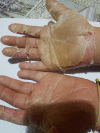The hidden scabies: a rare case of atypical Norwegian scabies, case report and literature review
- PMID: 38233867
- PMCID: PMC10795281
- DOI: 10.1186/s13052-023-01547-z
The hidden scabies: a rare case of atypical Norwegian scabies, case report and literature review
Abstract
Background: Norwegian scabies is a rare dermatological manifestation that usually affects the most fragile populations, such as elderly and immunocompromised patients, and its diagnosis is quite complex, due to its low prevalence in the general population and because of a broad spectrum manifestation.
Case presentation: Here we describe a rare case of Norwegian scabies that was previously misdiagnosed in a sixteen year old patient affected by Down syndrome and we conducted a non-systematic literature review about this topic. Lesions were atypical, pruritic and associated with periodic desquamation of the palms and soles and after a series of specialist evaluations, she finally underwent topical treatment with complete remission.
Conclusion: It is therefore crucial to take in consideration the relation between Down syndrome and community acquired crusted scabies, to enable preventative measures, early detection, and proper treatment.
Keywords: Children; Down syndrome; Immunodepression; Norwegian scabies; Scabies.
© 2023. The Author(s).
Conflict of interest statement
The authors declare that they have no competing interest.
Figures
References
-
- Guldbakke KK, Khachemoune A. Crusted scabies: a clinical review. J Drugs Dermatol. 2006;5:221–7. - PubMed
Publication types
MeSH terms
LinkOut - more resources
Full Text Sources
Medical




